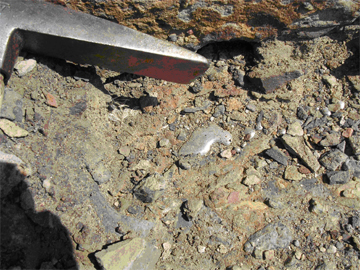Mercury: Introduction

Photo 1. Blebs of elemental mercury exposed in a breached conduit at the defunct Nikitovka mercury plant, Gorlovka, Ukraine (see Mercury Exposure in Ukraine). Photo by Allan Kolker, USGS.
Mercury (Hg) is an important trace element present in the environment because 1) mercury can occur in organic forms, such as methylmercury, which are highly toxic and can be bioconcentrated, biomagnified, and bioaccumulated in the food web, and 2) as an atmospheric constituent mercury can be transported long distances from its original source and eventually deposited back to the surface, possibly hundreds or thousands of miles away. Mercury has a complex biogeochemical cycle which allows it to be transferred between different ecosystem reservoirs and exhibit chemical transformations that control its behavior and toxicity (Figure 1.)

Figure 1. Simplified biogeochemical cycle of Mercury in the environment.
Researchers in the USGS Eastern Energy Resources Team and their colleagues are actively involved in studying the behavior and occurrence of mercury in the environment, as well as human exposures to mercury. Currently research is focused in six areas:
- Mercury in Coal – Coal naturally contains mercury in trace quantities, a portion of which is released during combustion for energy or heat generation. This project is examining the distribution and mode of occurrence of mercury in coal.
- Mercury Emissions from China – China is a uniquely large consumer of coal and is one of the largest emitters of atmospheric mercury. The project is providing information on mercury in China’s coal to help estimate emissions.
- Atmospheric Mercury Speciation – Mercury exists in the atmosphere in different forms (i.e., species). The behavior, formation, deposition, and sources of these different species are being studied in this project.
- Mercury Deposition Network - A cooperative U.S. and Canadian network of mercury wet deposition samplers has been deployed to quantify mercury deposition via rain and snow (i.e., wet deposition). The project focuses on results from the Culpeper, Virginia site which is run by USGS EERT and colleagues.
- Mercury Exposure in Ukraine – We are investigating mercury exposure and possible health effects from past mercury mining and use of mercury-rich coals in Gorlovka, Ukraine (Donbas region).
- Mercury Isotopes - Elemental isotopes are powerful tools for identifying potential sources and geochemical processes. This project investigates the distribution of mercury isotopes in geologic materials and their potential application for source identification.
Top of Page